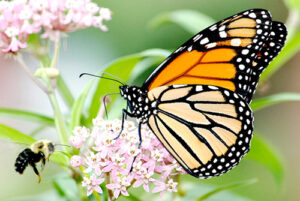The Oak Tree – A Bird Sanctuary?

 We associate birds with particular habitats and many with certain trees — Blue-winged warblers in locusts, kinglets in hemlocks, Red-cockaded woodpeckers in longleaf pines, Yellow-bellied sapsuckers on birches. And these days, many of us are putting native plants in our yards and gardens to attract and help pollinators like bees or butterflies.
We associate birds with particular habitats and many with certain trees — Blue-winged warblers in locusts, kinglets in hemlocks, Red-cockaded woodpeckers in longleaf pines, Yellow-bellied sapsuckers on birches. And these days, many of us are putting native plants in our yards and gardens to attract and help pollinators like bees or butterflies.
My parents would have been puzzled by the clover and buttercups I let sprout in my lawn, or the milkweed, joe pye, goldenrod, and other weedy stuff that filled the fields I roamed in as a boy before development paved almost all of Long Island.
 But who plants oak trees these days? They are the stuff of poetry and history, of yesteryear, as in “old oaken bucket.” So, I should admit that I have carefully tended a healthy red oak sapling in my garden since a squirrel put it there nearly 10 years ago despite the mature tulip poplars, pin oaks, some dogwoods, a hawthorn, a huge specimen Southern magnolia, and a neighbor’s massive beech tree that already create sylvan shade and leaf litter in for my modest suburban homestead. But I love oaks because I love shade and hate heat and humidity (and air conditioning bills) in sunny, sweaty Bethesda. And I know they sequester carbon dioxide and combat global warming.
But who plants oak trees these days? They are the stuff of poetry and history, of yesteryear, as in “old oaken bucket.” So, I should admit that I have carefully tended a healthy red oak sapling in my garden since a squirrel put it there nearly 10 years ago despite the mature tulip poplars, pin oaks, some dogwoods, a hawthorn, a huge specimen Southern magnolia, and a neighbor’s massive beech tree that already create sylvan shade and leaf litter in for my modest suburban homestead. But I love oaks because I love shade and hate heat and humidity (and air conditioning bills) in sunny, sweaty Bethesda. And I know they sequester carbon dioxide and combat global warming.
 Yet it took Adrian Higgins, the gardening columnist of the Washington Post, to remind me and convince me that solid, staid, stately oak trees are good for the pollinators and the birds as well. Their acorns feed turkeys, woodpeckers, crows, titmice and, of course Blue Jays. But drawing on native plant guru Doug Tallemy’s new book, Quercus, a kind of ode to oaks, Higgins discover that oaks support more forms of life than any other tree genus in America and that they are critical to migrating birds who eat the caterpillars of the many moths and butterflies that feast on young oak leaves. If you love butterflies and birds, you should plant some oaks. Adrian Higgins can explain how and why.
Yet it took Adrian Higgins, the gardening columnist of the Washington Post, to remind me and convince me that solid, staid, stately oak trees are good for the pollinators and the birds as well. Their acorns feed turkeys, woodpeckers, crows, titmice and, of course Blue Jays. But drawing on native plant guru Doug Tallemy’s new book, Quercus, a kind of ode to oaks, Higgins discover that oaks support more forms of life than any other tree genus in America and that they are critical to migrating birds who eat the caterpillars of the many moths and butterflies that feast on young oak leaves. If you love butterflies and birds, you should plant some oaks. Adrian Higgins can explain how and why.






